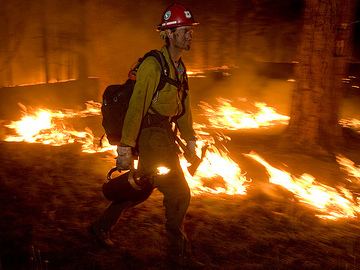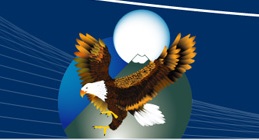New study finds American West especially vulnerable to wildfires over next three decades
The American West, where massive conflagrations are currently chewing up parts of Colorado and New Mexico, will be especially vulnerable to wildfires over the next three decades, according to scientists from the University of California-Berkeley and Texas Tech University.
Their study, published Tuesday in the peer-reviewed Ecosphere journal, utilized 16 separate climate change models and satellite-based databases to generate what researchers called one of the most comprehensive projections to date of how climate change might influence global fire patterns.

"In the long run, we found what most fear - increasing fire activity across large areas of the planet," lead author Max Moritz of UC Berkeley said in a statement. "But the speed and extent to which some of these changes may happen is surprising. These abrupt changes in fire patterns not only affects people's livelihoods, but also they add stress to native plants and animals that are already struggling to adapt to habitat loss."
Previous studies have also predicted an uptick in wildfires, severe storms, floods and droughts.
“Most of the previous wildfire projection studies focused on specific regions of the world, or relied upon only a handful of climate models,” said study co-author Katharine Hayhoe, director of the Climate Science Center at Texas Tech University. “When many different models paint the same picture, that gives us confidence that the results of our study reflect a robust fire frequency projection for that region. What is clear is that the choices we are making as a society right now and in the next few decades will determine what Earth's climate will look like over this century and beyond.”
In a different study published in the June issue of BioScience, UC-Berkeley researchers analyzed decades of data that supported the use of controlled burns to lessen fuels and better manage risk.
"We need to act, because climate change is making fire season longer, temperatures are going up, and that means more fire in many regions, particularly ones with a Mediterranean environment,” Berkeley's Scott Stephens said in a statement. "Based upon what we've found, forest managers can increase the scale and pace of necessary fuels treatments without worrying about unintended ecological consequences."
The U.S. Forest Service reports that less than 1 percent of prescribed burns rage out of control, which is what happened in Conifer this spring when winds whipped a burn into a deadly 4,000-acre blaze.
Experts say this summer has the potential to be one of the worst fire seasons in the history of Colorado, where a snow-starved winter, hot temperatures and beetle-killed forests have left the state especially susceptible. The state snowpack is only 2 percent of normal, according to a U.S. Department of Agriculture Basin Outlook Report released today (pdf).
In Larimer County, where the 46,000-acre High Park Fire has killed one person, destroyed over 100 structures and is already the third-largest fire in Colorado history, firefighters hope to have 10 percent containment at the end of the day. The fire is believed to have started from a lightning strike on Saturday.
Colorado's congressional delegation, led by Sens. Mark Udall and Michael Bennet, are urging the federal government to add air tankers and take other actions to improve preparedness for the coming years.
There are currently 19 active large fires burning in nine states. Federal agencies have made approximately 4,500 firefighters available to aid in efforts to suppress and contain the fires.
While today's fires are extremely serious ones, to date federal officials say the season has been "below average," meaning additional resources remain available should they be necessary.
"We're bringing the full range of our federal, tribal, state, local and non-governmental resources together to manage these wildland fires and reduce risk to communities," said Secretary of the Interior Ken Salazar. "We remain vigilant and continue to do all we can to ensure the safety of all firefighters in this challenging wildlife season."
![]() 0 Comments on "New study finds American West especially vulnerable to wildfires over next three decades"
0 Comments on "New study finds American West especially vulnerable to wildfires over next three decades"
Be the first to comment below.


 Vail Town Council to weigh new plan to redevelop T...
Vail Town Council to weigh new plan to redevelop T...  All about indexes
All about indexes  Transforming your social security into a winning r...
Transforming your social security into a winning r...  Pass sales, real estate transactions, revenues inc...
Pass sales, real estate transactions, revenues inc...  Vail Valley native with passion for Biophilic inte...
Vail Valley native with passion for Biophilic inte...  Beaver Creek starts work on new summer activities
Beaver Creek starts work on new summer activities  Land Trust, ECO Trails, Vail Resorts team up to cl...
Land Trust, ECO Trails, Vail Resorts team up to cl...  EUROVISION named Host Broadcaster for 2015 World A...
EUROVISION named Host Broadcaster for 2015 World A...  Vail Resorts brings back Lindsey Vonn's 'School of...
Vail Resorts brings back Lindsey Vonn's 'School of...  Hundreds turn out for 2015 World Championships vol...
Hundreds turn out for 2015 World Championships vol...  Eagle County Senior Health Expo and 9th Annual Hea...
Eagle County Senior Health Expo and 9th Annual Hea...  Final race of Vail Mountain Trail Running Series s...
Final race of Vail Mountain Trail Running Series s...  Before you write your will ...
Before you write your will ...  2015 World Ski Championships volunteer recruitment...
2015 World Ski Championships volunteer recruitment...  Ascent Sotheby’s International Realty in Vail an...
Ascent Sotheby’s International Realty in Vail an...  CDOT outlines road closures for local stages of US...
CDOT outlines road closures for local stages of US...  Italian artist creates unique trophies for Vail, B...
Italian artist creates unique trophies for Vail, B...  Vail Recreation District once again hosting Jake W...
Vail Recreation District once again hosting Jake W... 

